Analysis of Leadership and Management of Organisational Resources
VerifiedAdded on 2020/07/22
|12
|4049
|73
Report
AI Summary
This report examines the impact of an acquisition on leadership styles and organisational culture, using a case study of Co A and Co B. The analysis explores the shift from transformational leadership to autocratic leadership post-acquisition and its consequences, including employee turnover and decreased performance. The report delves into contemporary leadership approaches such as autocratic, transactional, and transformational leadership, and evaluates the impact of these styles on organisational culture. Furthermore, it suggests the application of the Kaleidoscope model for managing change within the firm, focusing on power dynamics and strategic development. The report also covers the cultural web model, the importance of leadership, and the need for change management to improve the company's performance.
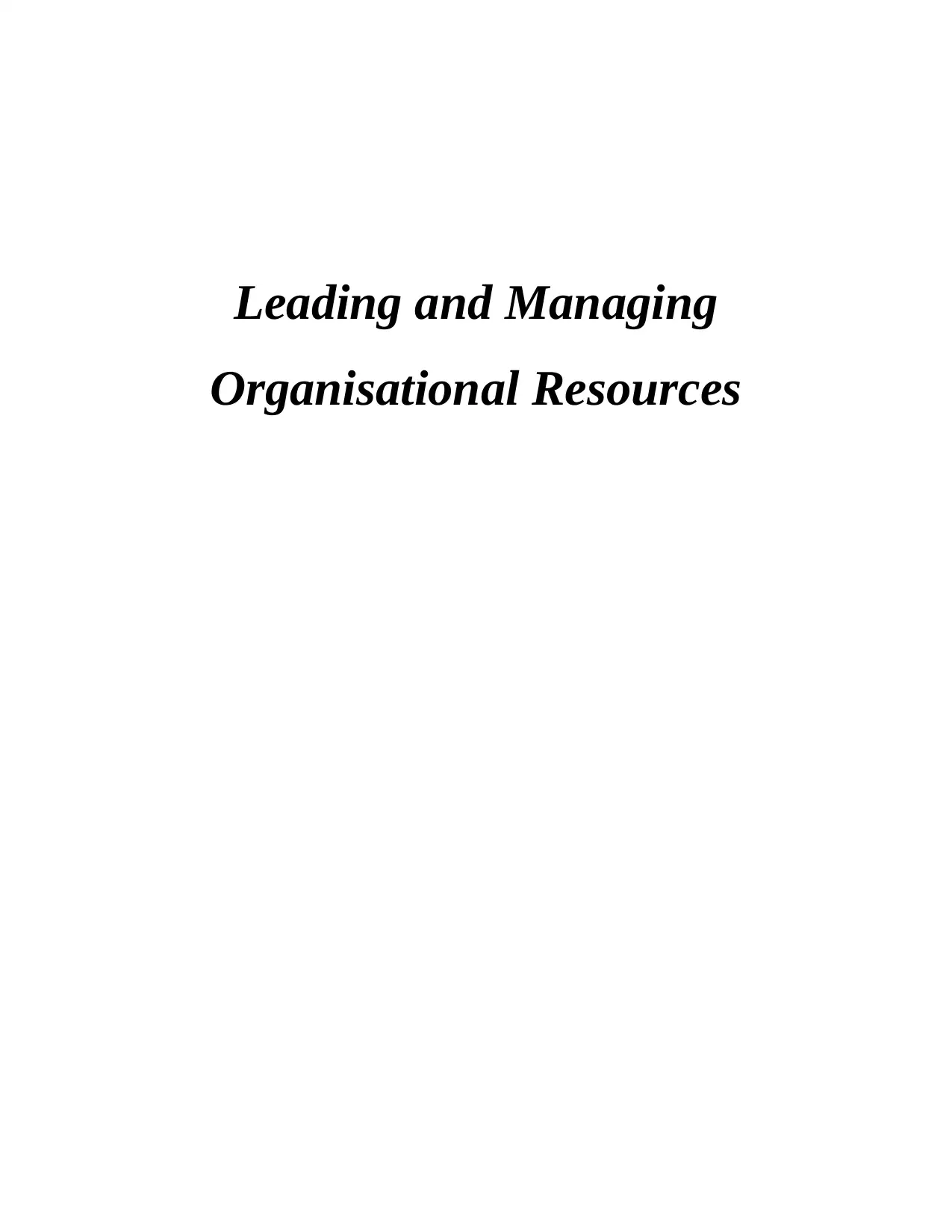
Leading and Managing
Organisational Resources
Organisational Resources
Paraphrase This Document
Need a fresh take? Get an instant paraphrase of this document with our AI Paraphraser
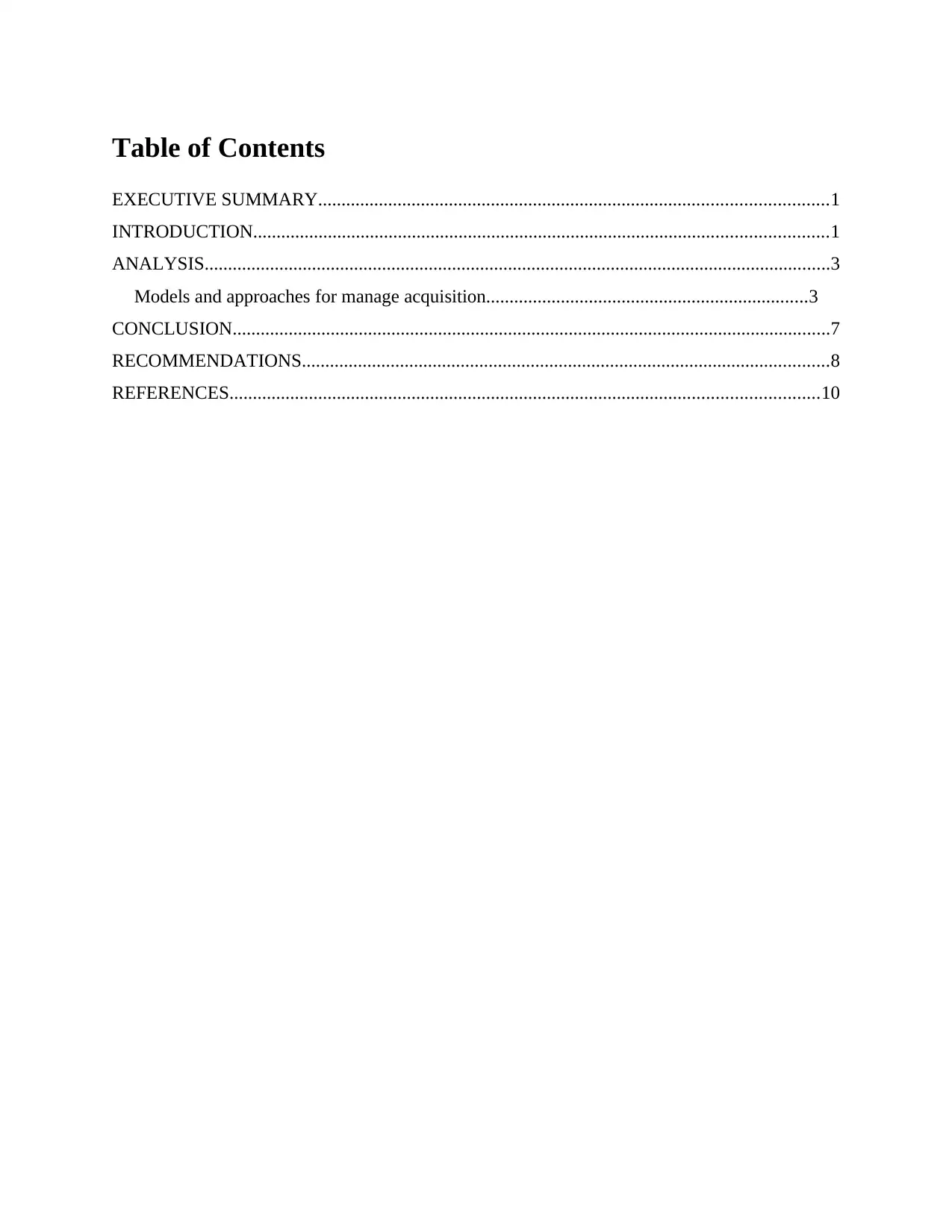
Table of Contents
EXECUTIVE SUMMARY.............................................................................................................1
INTRODUCTION...........................................................................................................................1
ANALYSIS......................................................................................................................................3
Models and approaches for manage acquisition.....................................................................3
CONCLUSION................................................................................................................................7
RECOMMENDATIONS.................................................................................................................8
REFERENCES..............................................................................................................................10
EXECUTIVE SUMMARY.............................................................................................................1
INTRODUCTION...........................................................................................................................1
ANALYSIS......................................................................................................................................3
Models and approaches for manage acquisition.....................................................................3
CONCLUSION................................................................................................................................7
RECOMMENDATIONS.................................................................................................................8
REFERENCES..............................................................................................................................10

EXECUTIVE SUMMARY
Acquisition is the process where one organisation purchase some or all of the ownership
stakes of the other organisation. The business report demonstrates the acquisition of Co A which
was acquired by Co B in September 2017. After post acquisition, the affect of the same can be
clearly seen on leadership style which completely changed after acquisition. The post-acquisition
leadership style implemented by Co B is autocratic leadership. In contrary to this, prior to
acquisition, Co A was following transactional and transformational leadership. Thus,
contemporary approaches to leadership can be described as autocratic, transactional and
transformational leadership. The organisation culture of Co A has been completely changed after
acquisition. The company was performing good in the past several years. The employees were
providing higher productivity and company was attaining desired revenue. But after acquisition
by Co B, the scenario completely changed in the manner which deteriorated performance of the
company. According to the given scenario after acquisition company, B should lay emphasis on
managing change within the firm. For this purpose, it can adopt Kaleidoscope model which aid
in managing the change with the organisation. This model is used to support strategic
development and changes along with this other topic like organisational change. It contains eight
components which help in measuring the positive, neutral and negative in the context of changes.
From the analysis of the case, it was identified that due to financial issues and problems, Co A
has been acquired by Company B. The corporate culture of Co A was efficient where
management listen to the employees and they were allowed to participate in the decision making
process of the company. The power is distributed among managers and leaders where they can
take decisions which gives benefits to the organisation.
INTRODUCTION
An acquisition is known as corporate action in which a company control other company
fully or partially. An acquisition take place at the time when a buying company obtains more
than 50% of ownership in a target company (Mergers and Acquisitions. 2015). The present
report is based on given case study of company A and B. Company A is an old company which
was established around 200 years ago. It carried out its business activities in different parts of the
countries such as USA, UK China etc. Along with this company A also focused on its staff
development and implement more innovative products and services. Further, organisation has
changes its leadership style due to which its performance of the company gets down. Another
1
Acquisition is the process where one organisation purchase some or all of the ownership
stakes of the other organisation. The business report demonstrates the acquisition of Co A which
was acquired by Co B in September 2017. After post acquisition, the affect of the same can be
clearly seen on leadership style which completely changed after acquisition. The post-acquisition
leadership style implemented by Co B is autocratic leadership. In contrary to this, prior to
acquisition, Co A was following transactional and transformational leadership. Thus,
contemporary approaches to leadership can be described as autocratic, transactional and
transformational leadership. The organisation culture of Co A has been completely changed after
acquisition. The company was performing good in the past several years. The employees were
providing higher productivity and company was attaining desired revenue. But after acquisition
by Co B, the scenario completely changed in the manner which deteriorated performance of the
company. According to the given scenario after acquisition company, B should lay emphasis on
managing change within the firm. For this purpose, it can adopt Kaleidoscope model which aid
in managing the change with the organisation. This model is used to support strategic
development and changes along with this other topic like organisational change. It contains eight
components which help in measuring the positive, neutral and negative in the context of changes.
From the analysis of the case, it was identified that due to financial issues and problems, Co A
has been acquired by Company B. The corporate culture of Co A was efficient where
management listen to the employees and they were allowed to participate in the decision making
process of the company. The power is distributed among managers and leaders where they can
take decisions which gives benefits to the organisation.
INTRODUCTION
An acquisition is known as corporate action in which a company control other company
fully or partially. An acquisition take place at the time when a buying company obtains more
than 50% of ownership in a target company (Mergers and Acquisitions. 2015). The present
report is based on given case study of company A and B. Company A is an old company which
was established around 200 years ago. It carried out its business activities in different parts of the
countries such as USA, UK China etc. Along with this company A also focused on its staff
development and implement more innovative products and services. Further, organisation has
changes its leadership style due to which its performance of the company gets down. Another
1
⊘ This is a preview!⊘
Do you want full access?
Subscribe today to unlock all pages.

Trusted by 1+ million students worldwide
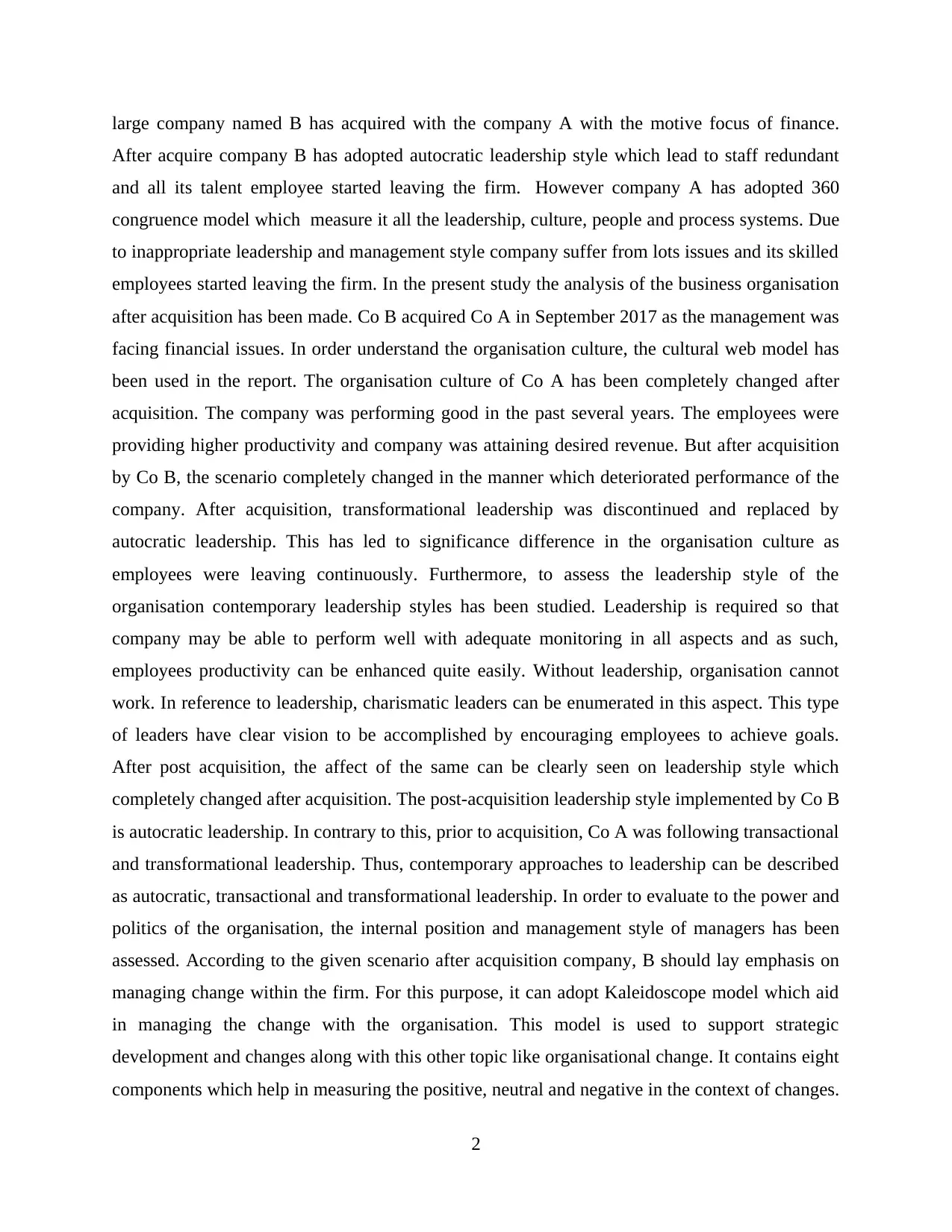
large company named B has acquired with the company A with the motive focus of finance.
After acquire company B has adopted autocratic leadership style which lead to staff redundant
and all its talent employee started leaving the firm. However company A has adopted 360
congruence model which measure it all the leadership, culture, people and process systems. Due
to inappropriate leadership and management style company suffer from lots issues and its skilled
employees started leaving the firm. In the present study the analysis of the business organisation
after acquisition has been made. Co B acquired Co A in September 2017 as the management was
facing financial issues. In order understand the organisation culture, the cultural web model has
been used in the report. The organisation culture of Co A has been completely changed after
acquisition. The company was performing good in the past several years. The employees were
providing higher productivity and company was attaining desired revenue. But after acquisition
by Co B, the scenario completely changed in the manner which deteriorated performance of the
company. After acquisition, transformational leadership was discontinued and replaced by
autocratic leadership. This has led to significance difference in the organisation culture as
employees were leaving continuously. Furthermore, to assess the leadership style of the
organisation contemporary leadership styles has been studied. Leadership is required so that
company may be able to perform well with adequate monitoring in all aspects and as such,
employees productivity can be enhanced quite easily. Without leadership, organisation cannot
work. In reference to leadership, charismatic leaders can be enumerated in this aspect. This type
of leaders have clear vision to be accomplished by encouraging employees to achieve goals.
After post acquisition, the affect of the same can be clearly seen on leadership style which
completely changed after acquisition. The post-acquisition leadership style implemented by Co B
is autocratic leadership. In contrary to this, prior to acquisition, Co A was following transactional
and transformational leadership. Thus, contemporary approaches to leadership can be described
as autocratic, transactional and transformational leadership. In order to evaluate to the power and
politics of the organisation, the internal position and management style of managers has been
assessed. According to the given scenario after acquisition company, B should lay emphasis on
managing change within the firm. For this purpose, it can adopt Kaleidoscope model which aid
in managing the change with the organisation. This model is used to support strategic
development and changes along with this other topic like organisational change. It contains eight
components which help in measuring the positive, neutral and negative in the context of changes.
2
After acquire company B has adopted autocratic leadership style which lead to staff redundant
and all its talent employee started leaving the firm. However company A has adopted 360
congruence model which measure it all the leadership, culture, people and process systems. Due
to inappropriate leadership and management style company suffer from lots issues and its skilled
employees started leaving the firm. In the present study the analysis of the business organisation
after acquisition has been made. Co B acquired Co A in September 2017 as the management was
facing financial issues. In order understand the organisation culture, the cultural web model has
been used in the report. The organisation culture of Co A has been completely changed after
acquisition. The company was performing good in the past several years. The employees were
providing higher productivity and company was attaining desired revenue. But after acquisition
by Co B, the scenario completely changed in the manner which deteriorated performance of the
company. After acquisition, transformational leadership was discontinued and replaced by
autocratic leadership. This has led to significance difference in the organisation culture as
employees were leaving continuously. Furthermore, to assess the leadership style of the
organisation contemporary leadership styles has been studied. Leadership is required so that
company may be able to perform well with adequate monitoring in all aspects and as such,
employees productivity can be enhanced quite easily. Without leadership, organisation cannot
work. In reference to leadership, charismatic leaders can be enumerated in this aspect. This type
of leaders have clear vision to be accomplished by encouraging employees to achieve goals.
After post acquisition, the affect of the same can be clearly seen on leadership style which
completely changed after acquisition. The post-acquisition leadership style implemented by Co B
is autocratic leadership. In contrary to this, prior to acquisition, Co A was following transactional
and transformational leadership. Thus, contemporary approaches to leadership can be described
as autocratic, transactional and transformational leadership. In order to evaluate to the power and
politics of the organisation, the internal position and management style of managers has been
assessed. According to the given scenario after acquisition company, B should lay emphasis on
managing change within the firm. For this purpose, it can adopt Kaleidoscope model which aid
in managing the change with the organisation. This model is used to support strategic
development and changes along with this other topic like organisational change. It contains eight
components which help in measuring the positive, neutral and negative in the context of changes.
2
Paraphrase This Document
Need a fresh take? Get an instant paraphrase of this document with our AI Paraphraser
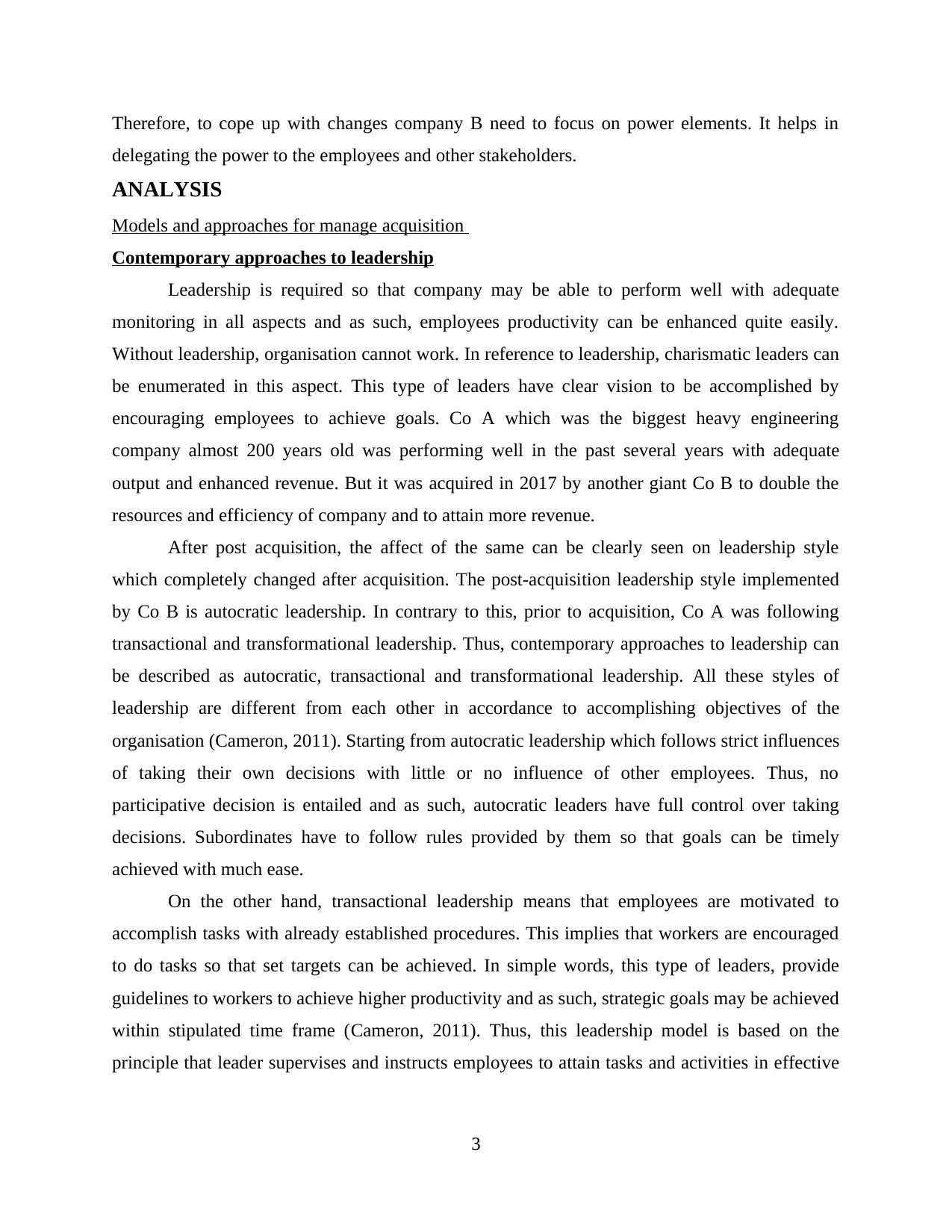
Therefore, to cope up with changes company B need to focus on power elements. It helps in
delegating the power to the employees and other stakeholders.
ANALYSIS
Models and approaches for manage acquisition
Contemporary approaches to leadership
Leadership is required so that company may be able to perform well with adequate
monitoring in all aspects and as such, employees productivity can be enhanced quite easily.
Without leadership, organisation cannot work. In reference to leadership, charismatic leaders can
be enumerated in this aspect. This type of leaders have clear vision to be accomplished by
encouraging employees to achieve goals. Co A which was the biggest heavy engineering
company almost 200 years old was performing well in the past several years with adequate
output and enhanced revenue. But it was acquired in 2017 by another giant Co B to double the
resources and efficiency of company and to attain more revenue.
After post acquisition, the affect of the same can be clearly seen on leadership style
which completely changed after acquisition. The post-acquisition leadership style implemented
by Co B is autocratic leadership. In contrary to this, prior to acquisition, Co A was following
transactional and transformational leadership. Thus, contemporary approaches to leadership can
be described as autocratic, transactional and transformational leadership. All these styles of
leadership are different from each other in accordance to accomplishing objectives of the
organisation (Cameron, 2011). Starting from autocratic leadership which follows strict influences
of taking their own decisions with little or no influence of other employees. Thus, no
participative decision is entailed and as such, autocratic leaders have full control over taking
decisions. Subordinates have to follow rules provided by them so that goals can be timely
achieved with much ease.
On the other hand, transactional leadership means that employees are motivated to
accomplish tasks with already established procedures. This implies that workers are encouraged
to do tasks so that set targets can be achieved. In simple words, this type of leaders, provide
guidelines to workers to achieve higher productivity and as such, strategic goals may be achieved
within stipulated time frame (Cameron, 2011). Thus, this leadership model is based on the
principle that leader supervises and instructs employees to attain tasks and activities in effective
3
delegating the power to the employees and other stakeholders.
ANALYSIS
Models and approaches for manage acquisition
Contemporary approaches to leadership
Leadership is required so that company may be able to perform well with adequate
monitoring in all aspects and as such, employees productivity can be enhanced quite easily.
Without leadership, organisation cannot work. In reference to leadership, charismatic leaders can
be enumerated in this aspect. This type of leaders have clear vision to be accomplished by
encouraging employees to achieve goals. Co A which was the biggest heavy engineering
company almost 200 years old was performing well in the past several years with adequate
output and enhanced revenue. But it was acquired in 2017 by another giant Co B to double the
resources and efficiency of company and to attain more revenue.
After post acquisition, the affect of the same can be clearly seen on leadership style
which completely changed after acquisition. The post-acquisition leadership style implemented
by Co B is autocratic leadership. In contrary to this, prior to acquisition, Co A was following
transactional and transformational leadership. Thus, contemporary approaches to leadership can
be described as autocratic, transactional and transformational leadership. All these styles of
leadership are different from each other in accordance to accomplishing objectives of the
organisation (Cameron, 2011). Starting from autocratic leadership which follows strict influences
of taking their own decisions with little or no influence of other employees. Thus, no
participative decision is entailed and as such, autocratic leaders have full control over taking
decisions. Subordinates have to follow rules provided by them so that goals can be timely
achieved with much ease.
On the other hand, transactional leadership means that employees are motivated to
accomplish tasks with already established procedures. This implies that workers are encouraged
to do tasks so that set targets can be achieved. In simple words, this type of leaders, provide
guidelines to workers to achieve higher productivity and as such, strategic goals may be achieved
within stipulated time frame (Cameron, 2011). Thus, this leadership model is based on the
principle that leader supervises and instructs employees to attain tasks and activities in effective
3
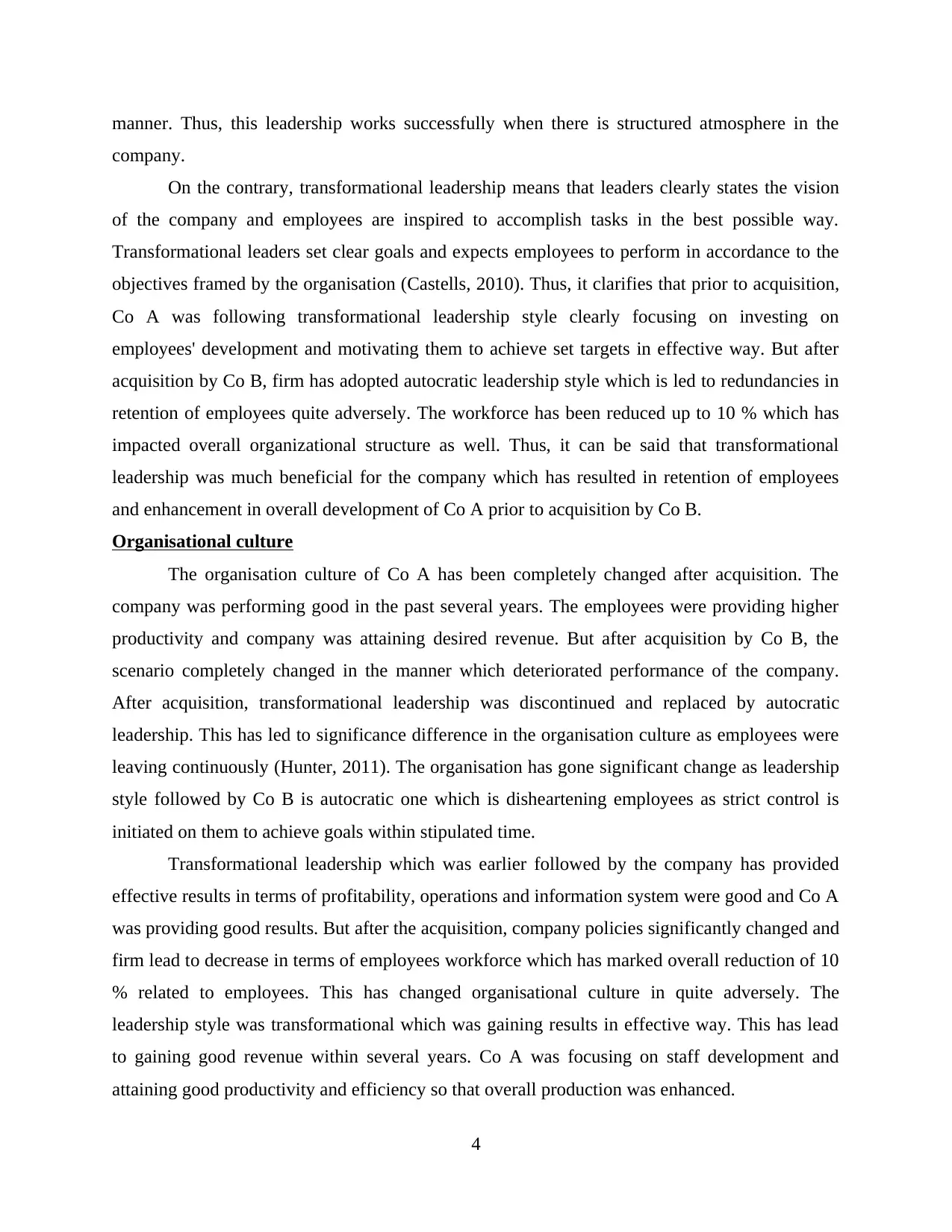
manner. Thus, this leadership works successfully when there is structured atmosphere in the
company.
On the contrary, transformational leadership means that leaders clearly states the vision
of the company and employees are inspired to accomplish tasks in the best possible way.
Transformational leaders set clear goals and expects employees to perform in accordance to the
objectives framed by the organisation (Castells, 2010). Thus, it clarifies that prior to acquisition,
Co A was following transformational leadership style clearly focusing on investing on
employees' development and motivating them to achieve set targets in effective way. But after
acquisition by Co B, firm has adopted autocratic leadership style which is led to redundancies in
retention of employees quite adversely. The workforce has been reduced up to 10 % which has
impacted overall organizational structure as well. Thus, it can be said that transformational
leadership was much beneficial for the company which has resulted in retention of employees
and enhancement in overall development of Co A prior to acquisition by Co B.
Organisational culture
The organisation culture of Co A has been completely changed after acquisition. The
company was performing good in the past several years. The employees were providing higher
productivity and company was attaining desired revenue. But after acquisition by Co B, the
scenario completely changed in the manner which deteriorated performance of the company.
After acquisition, transformational leadership was discontinued and replaced by autocratic
leadership. This has led to significance difference in the organisation culture as employees were
leaving continuously (Hunter, 2011). The organisation has gone significant change as leadership
style followed by Co B is autocratic one which is disheartening employees as strict control is
initiated on them to achieve goals within stipulated time.
Transformational leadership which was earlier followed by the company has provided
effective results in terms of profitability, operations and information system were good and Co A
was providing good results. But after the acquisition, company policies significantly changed and
firm lead to decrease in terms of employees workforce which has marked overall reduction of 10
% related to employees. This has changed organisational culture in quite adversely. The
leadership style was transformational which was gaining results in effective way. This has lead
to gaining good revenue within several years. Co A was focusing on staff development and
attaining good productivity and efficiency so that overall production was enhanced.
4
company.
On the contrary, transformational leadership means that leaders clearly states the vision
of the company and employees are inspired to accomplish tasks in the best possible way.
Transformational leaders set clear goals and expects employees to perform in accordance to the
objectives framed by the organisation (Castells, 2010). Thus, it clarifies that prior to acquisition,
Co A was following transformational leadership style clearly focusing on investing on
employees' development and motivating them to achieve set targets in effective way. But after
acquisition by Co B, firm has adopted autocratic leadership style which is led to redundancies in
retention of employees quite adversely. The workforce has been reduced up to 10 % which has
impacted overall organizational structure as well. Thus, it can be said that transformational
leadership was much beneficial for the company which has resulted in retention of employees
and enhancement in overall development of Co A prior to acquisition by Co B.
Organisational culture
The organisation culture of Co A has been completely changed after acquisition. The
company was performing good in the past several years. The employees were providing higher
productivity and company was attaining desired revenue. But after acquisition by Co B, the
scenario completely changed in the manner which deteriorated performance of the company.
After acquisition, transformational leadership was discontinued and replaced by autocratic
leadership. This has led to significance difference in the organisation culture as employees were
leaving continuously (Hunter, 2011). The organisation has gone significant change as leadership
style followed by Co B is autocratic one which is disheartening employees as strict control is
initiated on them to achieve goals within stipulated time.
Transformational leadership which was earlier followed by the company has provided
effective results in terms of profitability, operations and information system were good and Co A
was providing good results. But after the acquisition, company policies significantly changed and
firm lead to decrease in terms of employees workforce which has marked overall reduction of 10
% related to employees. This has changed organisational culture in quite adversely. The
leadership style was transformational which was gaining results in effective way. This has lead
to gaining good revenue within several years. Co A was focusing on staff development and
attaining good productivity and efficiency so that overall production was enhanced.
4
⊘ This is a preview!⊘
Do you want full access?
Subscribe today to unlock all pages.

Trusted by 1+ million students worldwide
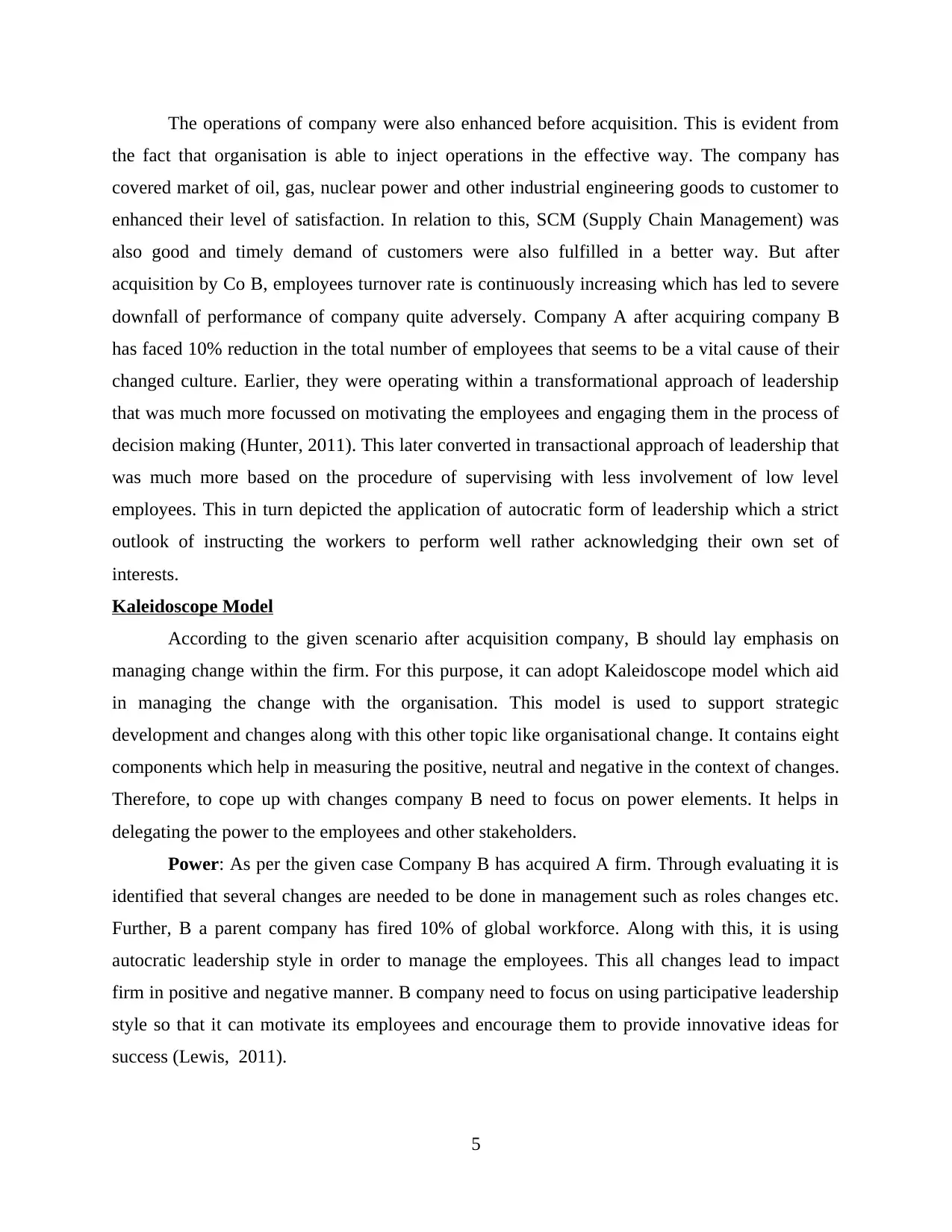
The operations of company were also enhanced before acquisition. This is evident from
the fact that organisation is able to inject operations in the effective way. The company has
covered market of oil, gas, nuclear power and other industrial engineering goods to customer to
enhanced their level of satisfaction. In relation to this, SCM (Supply Chain Management) was
also good and timely demand of customers were also fulfilled in a better way. But after
acquisition by Co B, employees turnover rate is continuously increasing which has led to severe
downfall of performance of company quite adversely. Company A after acquiring company B
has faced 10% reduction in the total number of employees that seems to be a vital cause of their
changed culture. Earlier, they were operating within a transformational approach of leadership
that was much more focussed on motivating the employees and engaging them in the process of
decision making (Hunter, 2011). This later converted in transactional approach of leadership that
was much more based on the procedure of supervising with less involvement of low level
employees. This in turn depicted the application of autocratic form of leadership which a strict
outlook of instructing the workers to perform well rather acknowledging their own set of
interests.
Kaleidoscope Model
According to the given scenario after acquisition company, B should lay emphasis on
managing change within the firm. For this purpose, it can adopt Kaleidoscope model which aid
in managing the change with the organisation. This model is used to support strategic
development and changes along with this other topic like organisational change. It contains eight
components which help in measuring the positive, neutral and negative in the context of changes.
Therefore, to cope up with changes company B need to focus on power elements. It helps in
delegating the power to the employees and other stakeholders.
Power: As per the given case Company B has acquired A firm. Through evaluating it is
identified that several changes are needed to be done in management such as roles changes etc.
Further, B a parent company has fired 10% of global workforce. Along with this, it is using
autocratic leadership style in order to manage the employees. This all changes lead to impact
firm in positive and negative manner. B company need to focus on using participative leadership
style so that it can motivate its employees and encourage them to provide innovative ideas for
success (Lewis, 2011).
5
the fact that organisation is able to inject operations in the effective way. The company has
covered market of oil, gas, nuclear power and other industrial engineering goods to customer to
enhanced their level of satisfaction. In relation to this, SCM (Supply Chain Management) was
also good and timely demand of customers were also fulfilled in a better way. But after
acquisition by Co B, employees turnover rate is continuously increasing which has led to severe
downfall of performance of company quite adversely. Company A after acquiring company B
has faced 10% reduction in the total number of employees that seems to be a vital cause of their
changed culture. Earlier, they were operating within a transformational approach of leadership
that was much more focussed on motivating the employees and engaging them in the process of
decision making (Hunter, 2011). This later converted in transactional approach of leadership that
was much more based on the procedure of supervising with less involvement of low level
employees. This in turn depicted the application of autocratic form of leadership which a strict
outlook of instructing the workers to perform well rather acknowledging their own set of
interests.
Kaleidoscope Model
According to the given scenario after acquisition company, B should lay emphasis on
managing change within the firm. For this purpose, it can adopt Kaleidoscope model which aid
in managing the change with the organisation. This model is used to support strategic
development and changes along with this other topic like organisational change. It contains eight
components which help in measuring the positive, neutral and negative in the context of changes.
Therefore, to cope up with changes company B need to focus on power elements. It helps in
delegating the power to the employees and other stakeholders.
Power: As per the given case Company B has acquired A firm. Through evaluating it is
identified that several changes are needed to be done in management such as roles changes etc.
Further, B a parent company has fired 10% of global workforce. Along with this, it is using
autocratic leadership style in order to manage the employees. This all changes lead to impact
firm in positive and negative manner. B company need to focus on using participative leadership
style so that it can motivate its employees and encourage them to provide innovative ideas for
success (Lewis, 2011).
5
Paraphrase This Document
Need a fresh take? Get an instant paraphrase of this document with our AI Paraphraser
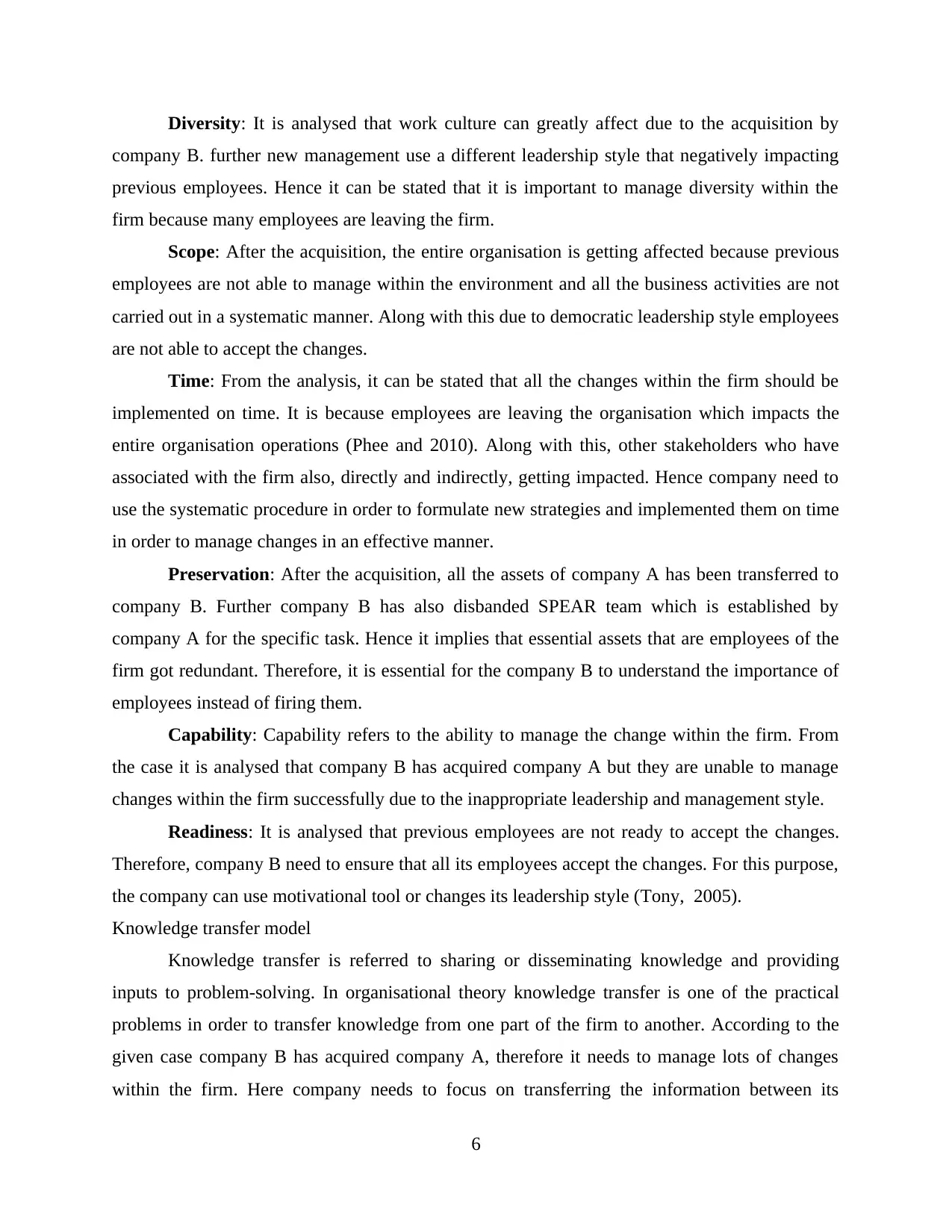
Diversity: It is analysed that work culture can greatly affect due to the acquisition by
company B. further new management use a different leadership style that negatively impacting
previous employees. Hence it can be stated that it is important to manage diversity within the
firm because many employees are leaving the firm.
Scope: After the acquisition, the entire organisation is getting affected because previous
employees are not able to manage within the environment and all the business activities are not
carried out in a systematic manner. Along with this due to democratic leadership style employees
are not able to accept the changes.
Time: From the analysis, it can be stated that all the changes within the firm should be
implemented on time. It is because employees are leaving the organisation which impacts the
entire organisation operations (Phee and 2010). Along with this, other stakeholders who have
associated with the firm also, directly and indirectly, getting impacted. Hence company need to
use the systematic procedure in order to formulate new strategies and implemented them on time
in order to manage changes in an effective manner.
Preservation: After the acquisition, all the assets of company A has been transferred to
company B. Further company B has also disbanded SPEAR team which is established by
company A for the specific task. Hence it implies that essential assets that are employees of the
firm got redundant. Therefore, it is essential for the company B to understand the importance of
employees instead of firing them.
Capability: Capability refers to the ability to manage the change within the firm. From
the case it is analysed that company B has acquired company A but they are unable to manage
changes within the firm successfully due to the inappropriate leadership and management style.
Readiness: It is analysed that previous employees are not ready to accept the changes.
Therefore, company B need to ensure that all its employees accept the changes. For this purpose,
the company can use motivational tool or changes its leadership style (Tony, 2005).
Knowledge transfer model
Knowledge transfer is referred to sharing or disseminating knowledge and providing
inputs to problem-solving. In organisational theory knowledge transfer is one of the practical
problems in order to transfer knowledge from one part of the firm to another. According to the
given case company B has acquired company A, therefore it needs to manage lots of changes
within the firm. Here company needs to focus on transferring the information between its
6
company B. further new management use a different leadership style that negatively impacting
previous employees. Hence it can be stated that it is important to manage diversity within the
firm because many employees are leaving the firm.
Scope: After the acquisition, the entire organisation is getting affected because previous
employees are not able to manage within the environment and all the business activities are not
carried out in a systematic manner. Along with this due to democratic leadership style employees
are not able to accept the changes.
Time: From the analysis, it can be stated that all the changes within the firm should be
implemented on time. It is because employees are leaving the organisation which impacts the
entire organisation operations (Phee and 2010). Along with this, other stakeholders who have
associated with the firm also, directly and indirectly, getting impacted. Hence company need to
use the systematic procedure in order to formulate new strategies and implemented them on time
in order to manage changes in an effective manner.
Preservation: After the acquisition, all the assets of company A has been transferred to
company B. Further company B has also disbanded SPEAR team which is established by
company A for the specific task. Hence it implies that essential assets that are employees of the
firm got redundant. Therefore, it is essential for the company B to understand the importance of
employees instead of firing them.
Capability: Capability refers to the ability to manage the change within the firm. From
the case it is analysed that company B has acquired company A but they are unable to manage
changes within the firm successfully due to the inappropriate leadership and management style.
Readiness: It is analysed that previous employees are not ready to accept the changes.
Therefore, company B need to ensure that all its employees accept the changes. For this purpose,
the company can use motivational tool or changes its leadership style (Tony, 2005).
Knowledge transfer model
Knowledge transfer is referred to sharing or disseminating knowledge and providing
inputs to problem-solving. In organisational theory knowledge transfer is one of the practical
problems in order to transfer knowledge from one part of the firm to another. According to the
given case company B has acquired company A, therefore it needs to manage lots of changes
within the firm. Here company needs to focus on transferring the information between its
6
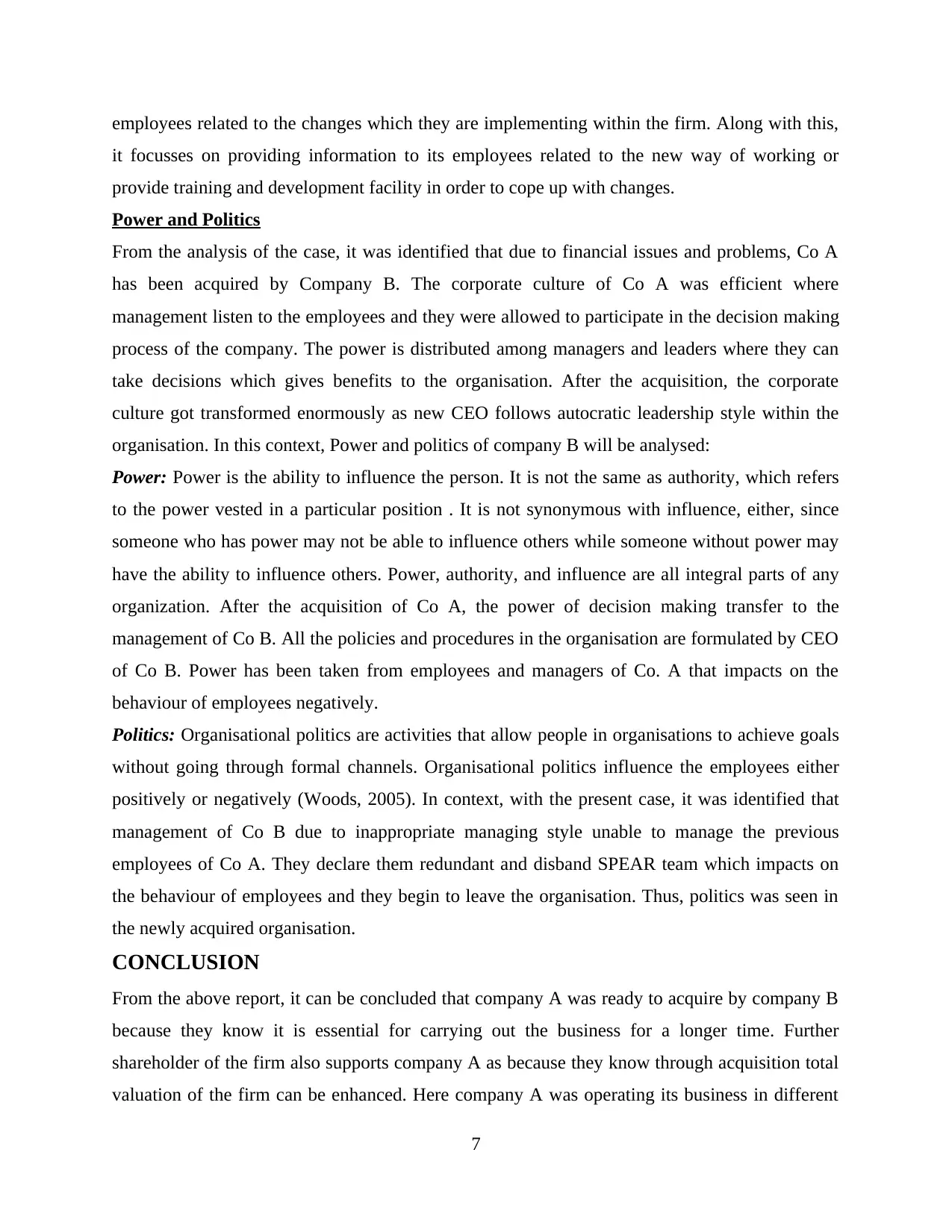
employees related to the changes which they are implementing within the firm. Along with this,
it focusses on providing information to its employees related to the new way of working or
provide training and development facility in order to cope up with changes.
Power and Politics
From the analysis of the case, it was identified that due to financial issues and problems, Co A
has been acquired by Company B. The corporate culture of Co A was efficient where
management listen to the employees and they were allowed to participate in the decision making
process of the company. The power is distributed among managers and leaders where they can
take decisions which gives benefits to the organisation. After the acquisition, the corporate
culture got transformed enormously as new CEO follows autocratic leadership style within the
organisation. In this context, Power and politics of company B will be analysed:
Power: Power is the ability to influence the person. It is not the same as authority, which refers
to the power vested in a particular position . It is not synonymous with influence, either, since
someone who has power may not be able to influence others while someone without power may
have the ability to influence others. Power, authority, and influence are all integral parts of any
organization. After the acquisition of Co A, the power of decision making transfer to the
management of Co B. All the policies and procedures in the organisation are formulated by CEO
of Co B. Power has been taken from employees and managers of Co. A that impacts on the
behaviour of employees negatively.
Politics: Organisational politics are activities that allow people in organisations to achieve goals
without going through formal channels. Organisational politics influence the employees either
positively or negatively (Woods, 2005). In context, with the present case, it was identified that
management of Co B due to inappropriate managing style unable to manage the previous
employees of Co A. They declare them redundant and disband SPEAR team which impacts on
the behaviour of employees and they begin to leave the organisation. Thus, politics was seen in
the newly acquired organisation.
CONCLUSION
From the above report, it can be concluded that company A was ready to acquire by company B
because they know it is essential for carrying out the business for a longer time. Further
shareholder of the firm also supports company A as because they know through acquisition total
valuation of the firm can be enhanced. Here company A was operating its business in different
7
it focusses on providing information to its employees related to the new way of working or
provide training and development facility in order to cope up with changes.
Power and Politics
From the analysis of the case, it was identified that due to financial issues and problems, Co A
has been acquired by Company B. The corporate culture of Co A was efficient where
management listen to the employees and they were allowed to participate in the decision making
process of the company. The power is distributed among managers and leaders where they can
take decisions which gives benefits to the organisation. After the acquisition, the corporate
culture got transformed enormously as new CEO follows autocratic leadership style within the
organisation. In this context, Power and politics of company B will be analysed:
Power: Power is the ability to influence the person. It is not the same as authority, which refers
to the power vested in a particular position . It is not synonymous with influence, either, since
someone who has power may not be able to influence others while someone without power may
have the ability to influence others. Power, authority, and influence are all integral parts of any
organization. After the acquisition of Co A, the power of decision making transfer to the
management of Co B. All the policies and procedures in the organisation are formulated by CEO
of Co B. Power has been taken from employees and managers of Co. A that impacts on the
behaviour of employees negatively.
Politics: Organisational politics are activities that allow people in organisations to achieve goals
without going through formal channels. Organisational politics influence the employees either
positively or negatively (Woods, 2005). In context, with the present case, it was identified that
management of Co B due to inappropriate managing style unable to manage the previous
employees of Co A. They declare them redundant and disband SPEAR team which impacts on
the behaviour of employees and they begin to leave the organisation. Thus, politics was seen in
the newly acquired organisation.
CONCLUSION
From the above report, it can be concluded that company A was ready to acquire by company B
because they know it is essential for carrying out the business for a longer time. Further
shareholder of the firm also supports company A as because they know through acquisition total
valuation of the firm can be enhanced. Here company A was operating its business in different
7
⊘ This is a preview!⊘
Do you want full access?
Subscribe today to unlock all pages.

Trusted by 1+ million students worldwide
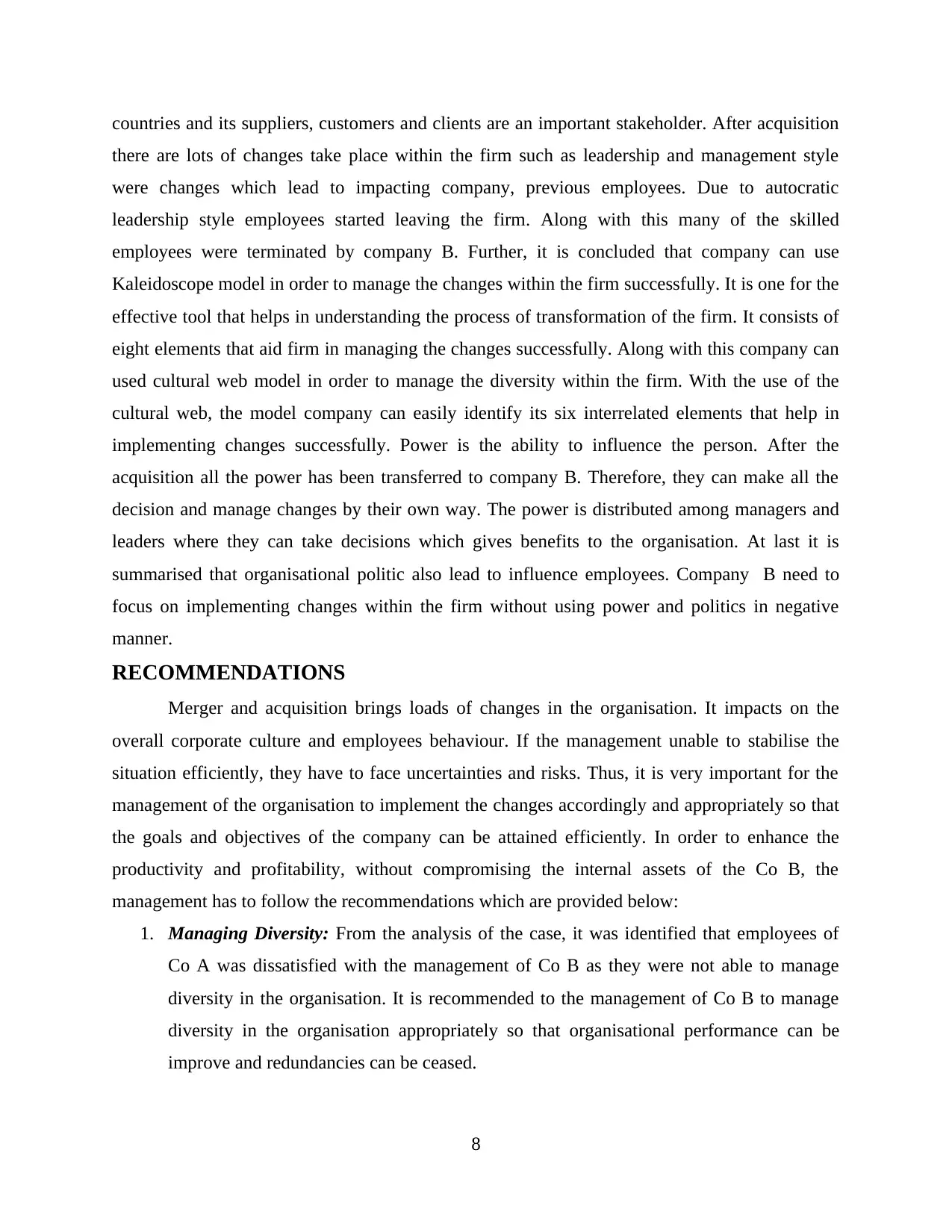
countries and its suppliers, customers and clients are an important stakeholder. After acquisition
there are lots of changes take place within the firm such as leadership and management style
were changes which lead to impacting company, previous employees. Due to autocratic
leadership style employees started leaving the firm. Along with this many of the skilled
employees were terminated by company B. Further, it is concluded that company can use
Kaleidoscope model in order to manage the changes within the firm successfully. It is one for the
effective tool that helps in understanding the process of transformation of the firm. It consists of
eight elements that aid firm in managing the changes successfully. Along with this company can
used cultural web model in order to manage the diversity within the firm. With the use of the
cultural web, the model company can easily identify its six interrelated elements that help in
implementing changes successfully. Power is the ability to influence the person. After the
acquisition all the power has been transferred to company B. Therefore, they can make all the
decision and manage changes by their own way. The power is distributed among managers and
leaders where they can take decisions which gives benefits to the organisation. At last it is
summarised that organisational politic also lead to influence employees. Company B need to
focus on implementing changes within the firm without using power and politics in negative
manner.
RECOMMENDATIONS
Merger and acquisition brings loads of changes in the organisation. It impacts on the
overall corporate culture and employees behaviour. If the management unable to stabilise the
situation efficiently, they have to face uncertainties and risks. Thus, it is very important for the
management of the organisation to implement the changes accordingly and appropriately so that
the goals and objectives of the company can be attained efficiently. In order to enhance the
productivity and profitability, without compromising the internal assets of the Co B, the
management has to follow the recommendations which are provided below:
1. Managing Diversity: From the analysis of the case, it was identified that employees of
Co A was dissatisfied with the management of Co B as they were not able to manage
diversity in the organisation. It is recommended to the management of Co B to manage
diversity in the organisation appropriately so that organisational performance can be
improve and redundancies can be ceased.
8
there are lots of changes take place within the firm such as leadership and management style
were changes which lead to impacting company, previous employees. Due to autocratic
leadership style employees started leaving the firm. Along with this many of the skilled
employees were terminated by company B. Further, it is concluded that company can use
Kaleidoscope model in order to manage the changes within the firm successfully. It is one for the
effective tool that helps in understanding the process of transformation of the firm. It consists of
eight elements that aid firm in managing the changes successfully. Along with this company can
used cultural web model in order to manage the diversity within the firm. With the use of the
cultural web, the model company can easily identify its six interrelated elements that help in
implementing changes successfully. Power is the ability to influence the person. After the
acquisition all the power has been transferred to company B. Therefore, they can make all the
decision and manage changes by their own way. The power is distributed among managers and
leaders where they can take decisions which gives benefits to the organisation. At last it is
summarised that organisational politic also lead to influence employees. Company B need to
focus on implementing changes within the firm without using power and politics in negative
manner.
RECOMMENDATIONS
Merger and acquisition brings loads of changes in the organisation. It impacts on the
overall corporate culture and employees behaviour. If the management unable to stabilise the
situation efficiently, they have to face uncertainties and risks. Thus, it is very important for the
management of the organisation to implement the changes accordingly and appropriately so that
the goals and objectives of the company can be attained efficiently. In order to enhance the
productivity and profitability, without compromising the internal assets of the Co B, the
management has to follow the recommendations which are provided below:
1. Managing Diversity: From the analysis of the case, it was identified that employees of
Co A was dissatisfied with the management of Co B as they were not able to manage
diversity in the organisation. It is recommended to the management of Co B to manage
diversity in the organisation appropriately so that organisational performance can be
improve and redundancies can be ceased.
8
Paraphrase This Document
Need a fresh take? Get an instant paraphrase of this document with our AI Paraphraser
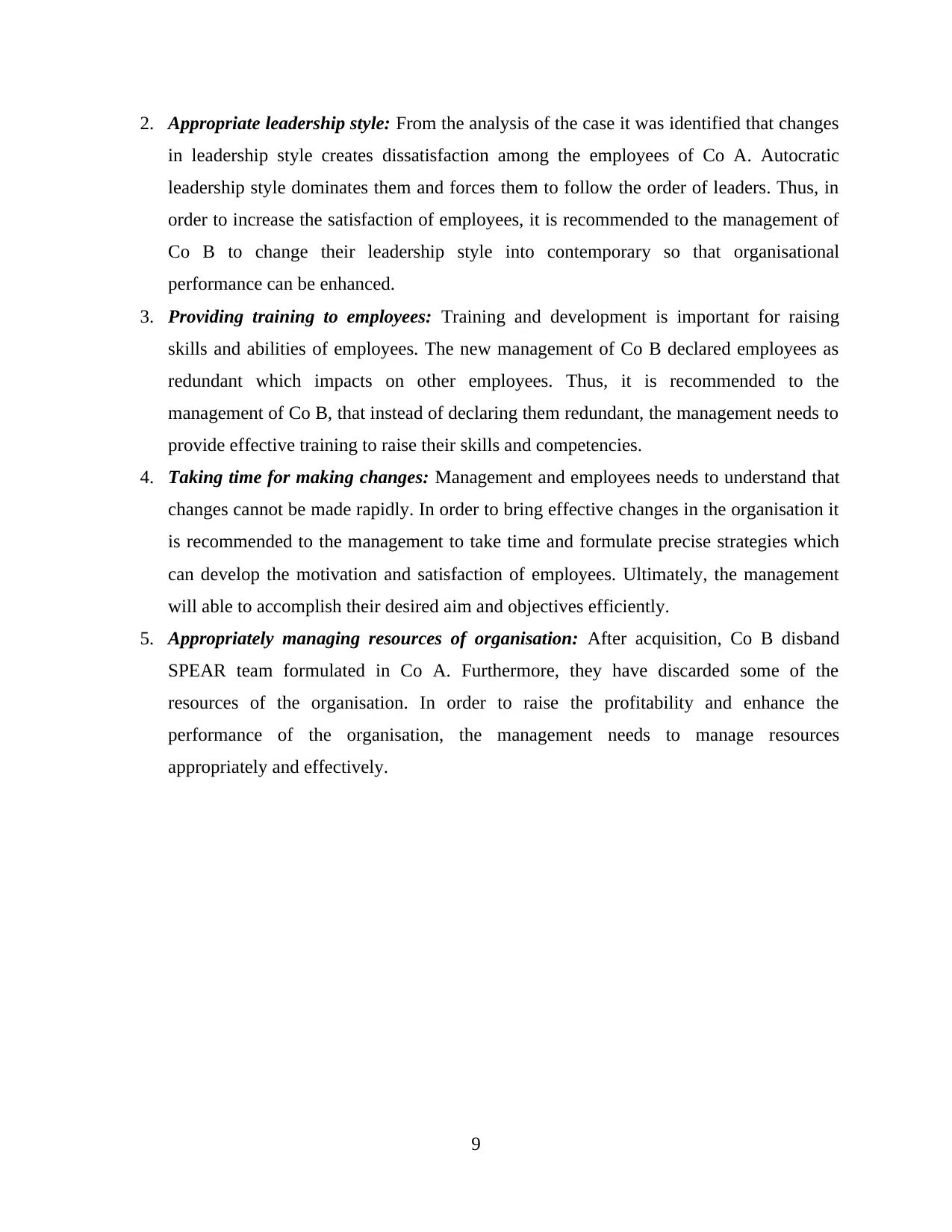
2. Appropriate leadership style: From the analysis of the case it was identified that changes
in leadership style creates dissatisfaction among the employees of Co A. Autocratic
leadership style dominates them and forces them to follow the order of leaders. Thus, in
order to increase the satisfaction of employees, it is recommended to the management of
Co B to change their leadership style into contemporary so that organisational
performance can be enhanced.
3. Providing training to employees: Training and development is important for raising
skills and abilities of employees. The new management of Co B declared employees as
redundant which impacts on other employees. Thus, it is recommended to the
management of Co B, that instead of declaring them redundant, the management needs to
provide effective training to raise their skills and competencies.
4. Taking time for making changes: Management and employees needs to understand that
changes cannot be made rapidly. In order to bring effective changes in the organisation it
is recommended to the management to take time and formulate precise strategies which
can develop the motivation and satisfaction of employees. Ultimately, the management
will able to accomplish their desired aim and objectives efficiently.
5. Appropriately managing resources of organisation: After acquisition, Co B disband
SPEAR team formulated in Co A. Furthermore, they have discarded some of the
resources of the organisation. In order to raise the profitability and enhance the
performance of the organisation, the management needs to manage resources
appropriately and effectively.
9
in leadership style creates dissatisfaction among the employees of Co A. Autocratic
leadership style dominates them and forces them to follow the order of leaders. Thus, in
order to increase the satisfaction of employees, it is recommended to the management of
Co B to change their leadership style into contemporary so that organisational
performance can be enhanced.
3. Providing training to employees: Training and development is important for raising
skills and abilities of employees. The new management of Co B declared employees as
redundant which impacts on other employees. Thus, it is recommended to the
management of Co B, that instead of declaring them redundant, the management needs to
provide effective training to raise their skills and competencies.
4. Taking time for making changes: Management and employees needs to understand that
changes cannot be made rapidly. In order to bring effective changes in the organisation it
is recommended to the management to take time and formulate precise strategies which
can develop the motivation and satisfaction of employees. Ultimately, the management
will able to accomplish their desired aim and objectives efficiently.
5. Appropriately managing resources of organisation: After acquisition, Co B disband
SPEAR team formulated in Co A. Furthermore, they have discarded some of the
resources of the organisation. In order to raise the profitability and enhance the
performance of the organisation, the management needs to manage resources
appropriately and effectively.
9
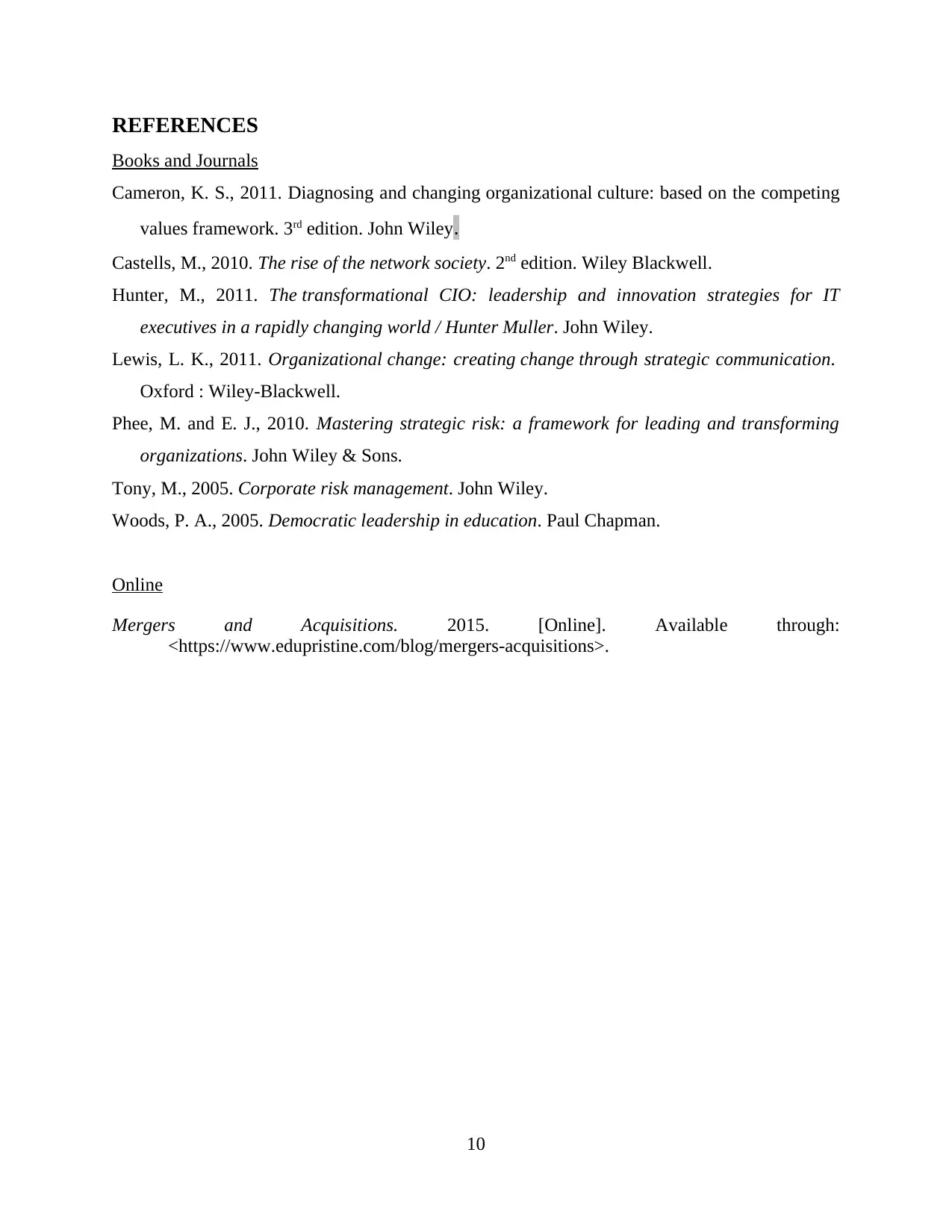
REFERENCES
Books and Journals
Cameron, K. S., 2011. Diagnosing and changing organizational culture: based on the competing
values framework. 3rd edition. John Wiley.
Castells, M., 2010. The rise of the network society. 2nd edition. Wiley Blackwell.
Hunter, M., 2011. The transformational CIO: leadership and innovation strategies for IT
executives in a rapidly changing world / Hunter Muller. John Wiley.
Lewis, L. K., 2011. Organizational change: creating change through strategic communication.
Oxford : Wiley-Blackwell.
Phee, M. and E. J., 2010. Mastering strategic risk: a framework for leading and transforming
organizations. John Wiley & Sons.
Tony, M., 2005. Corporate risk management. John Wiley.
Woods, P. A., 2005. Democratic leadership in education. Paul Chapman.
Online
Mergers and Acquisitions. 2015. [Online]. Available through:
<https://www.edupristine.com/blog/mergers-acquisitions>.
10
Books and Journals
Cameron, K. S., 2011. Diagnosing and changing organizational culture: based on the competing
values framework. 3rd edition. John Wiley.
Castells, M., 2010. The rise of the network society. 2nd edition. Wiley Blackwell.
Hunter, M., 2011. The transformational CIO: leadership and innovation strategies for IT
executives in a rapidly changing world / Hunter Muller. John Wiley.
Lewis, L. K., 2011. Organizational change: creating change through strategic communication.
Oxford : Wiley-Blackwell.
Phee, M. and E. J., 2010. Mastering strategic risk: a framework for leading and transforming
organizations. John Wiley & Sons.
Tony, M., 2005. Corporate risk management. John Wiley.
Woods, P. A., 2005. Democratic leadership in education. Paul Chapman.
Online
Mergers and Acquisitions. 2015. [Online]. Available through:
<https://www.edupristine.com/blog/mergers-acquisitions>.
10
⊘ This is a preview!⊘
Do you want full access?
Subscribe today to unlock all pages.

Trusted by 1+ million students worldwide
1 out of 12
Related Documents
Your All-in-One AI-Powered Toolkit for Academic Success.
+13062052269
info@desklib.com
Available 24*7 on WhatsApp / Email
![[object Object]](/_next/static/media/star-bottom.7253800d.svg)
Unlock your academic potential
Copyright © 2020–2026 A2Z Services. All Rights Reserved. Developed and managed by ZUCOL.





